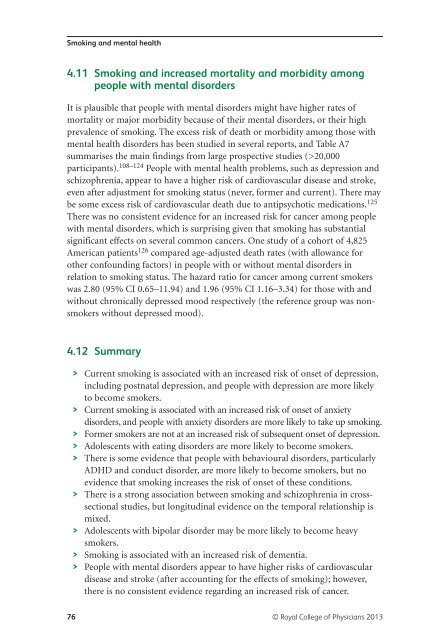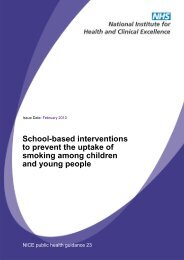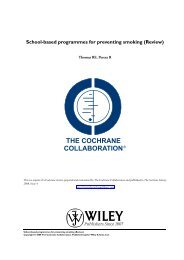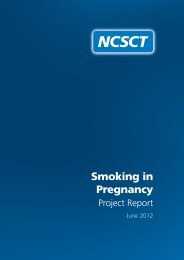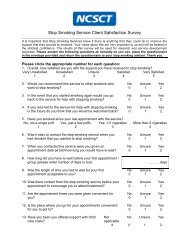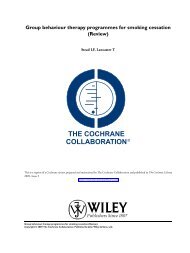Smoking and mental health - NCSCT
Smoking and mental health - NCSCT
Smoking and mental health - NCSCT
Create successful ePaper yourself
Turn your PDF publications into a flip-book with our unique Google optimized e-Paper software.
<strong>Smoking</strong> <strong>and</strong> <strong>mental</strong> <strong>health</strong><br />
4.11 <strong>Smoking</strong> <strong>and</strong> increased mortality <strong>and</strong> morbidity among<br />
people with <strong>mental</strong> disorders<br />
It is plausible that people with <strong>mental</strong> disorders might have higher rates of<br />
mortality or major morbidity because of their <strong>mental</strong> disorders, or their high<br />
prevalence of smoking. The excess risk of death or morbidity among those with<br />
<strong>mental</strong> <strong>health</strong> disorders has been studied in several reports, <strong>and</strong> Table A7<br />
summarises the main findings from large prospective studies (>20,000<br />
participants). 108–124 People with <strong>mental</strong> <strong>health</strong> problems, such as depression <strong>and</strong><br />
schizophrenia, appear to have a higher risk of cardiovascular disease <strong>and</strong> stroke,<br />
even after adjustment for smoking status (never, former <strong>and</strong> current). There may<br />
be some excess risk of cardiovascular death due to antipsychotic medications. 125<br />
There was no consistent evidence for an increased risk for cancer among people<br />
with <strong>mental</strong> disorders, which is surprising given that smoking has substantial<br />
significant effects on several common cancers. One study of a cohort of 4,825<br />
American patients 126 compared age-adjusted death rates (with allowance for<br />
other confounding factors) in people with or without <strong>mental</strong> disorders in<br />
relation to smoking status. The hazard ratio for cancer among current smokers<br />
was 2.80 (95% CI 0.65–11.94) <strong>and</strong> 1.96 (95% CI 1.16–3.34) for those with <strong>and</strong><br />
without chronically depressed mood respectively (the reference group was nonsmokers<br />
without depressed mood).<br />
4.12 Summary<br />
> Current smoking is associated with an increased risk of onset of depression,<br />
including postnatal depression, <strong>and</strong> people with depression are more likely<br />
to become smokers.<br />
> Current smoking is associated with an increased risk of onset of anxiety<br />
disorders, <strong>and</strong> people with anxiety disorders are more likely to take up smoking.<br />
> Former smokers are not at an increased risk of subsequent onset of depression.<br />
> Adolescents with eating disorders are more likely to become smokers.<br />
> There is some evidence that people with behavioural disorders, particularly<br />
ADHD <strong>and</strong> conduct disorder, are more likely to become smokers, but no<br />
evidence that smoking increases the risk of onset of these conditions.<br />
> There is a strong association between smoking <strong>and</strong> schizophrenia in crosssectional<br />
studies, but longitudinal evidence on the temporal relationship is<br />
mixed.<br />
> Adolescents with bipolar disorder may be more likely to become heavy<br />
smokers.<br />
> <strong>Smoking</strong> is associated with an increased risk of dementia.<br />
> People with <strong>mental</strong> disorders appear to have higher risks of cardiovascular<br />
disease <strong>and</strong> stroke (after accounting for the effects of smoking); however,<br />
there is no consistent evidence regarding an increased risk of cancer.<br />
76 © Royal College of Physicians 2013


